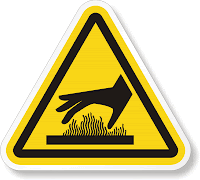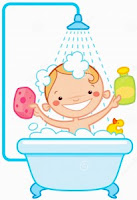Yesterday, one of my contacts on LinkedIn reminded me that this week - February 4 - 10 - is National Burn Awareness Week, so I made myself a reminder to blog on it today. Then, last night, I heard about the latest video "challenge" -- being videotaped with your arm/hand resting on the lit eye of an electric stove. That made my topic for this blog a no-brainer.
Electrical burns
Go through each room of your home and cover (inserted into the socket) outlets to ensure that children can't insert coins or other objects which could cause an electrical shock or start a fire. Additionally, be extremely careful when using an electrical appliance near water such as the kitchen sink or the shower.
Kitchen burn injuries
Never, I repeat, never leave food unattended and cooking on the stove. During my 25 years with the fire service, I have lost count of how many fires we responded to that were a direct result of food left unattended on the stove. You can prevent potentially hazardous spill (and burns) by turning pot handles where they are facing toward the back of the stove and using the back eyelet from foods the poise a spill hazard. (Kitchen fire video [YouTube]).
Preventing scald burn
A scald is a burn that result from exposure to - or coming in contact with - hot liquids or steam. Studies have shown that sixty-five percent (65%) of children hospitalized for treatment of a burn injury, suffered it as a result of coming into contact with a scalding liquid -- particularly bath water than was too hot. That being said, check your water heater and make sure that it's set no higher that 120 degrees Fahrenheit (48.8 degrees Celsius). Also, safety experts recommend when drawing bath water for a child, run the cold water first and add the warm water in when the tub is approximately half-full.
Adults are not exempt from scald injuries. One of the most common such injury's results from the dishwasher. Use EXTREME caution when opening it at the end of the drying cycle. It's also a good rule of thumb to be careful when removing food cooked or heated in the microwave since it doesn't heat evenly.
My sources:
Georgia Firefighters Burn Foundation (GFBF)
Safety smart 911
Electrical burns
Go through each room of your home and cover (inserted into the socket) outlets to ensure that children can't insert coins or other objects which could cause an electrical shock or start a fire. Additionally, be extremely careful when using an electrical appliance near water such as the kitchen sink or the shower.
Kitchen burn injuries
Never, I repeat, never leave food unattended and cooking on the stove. During my 25 years with the fire service, I have lost count of how many fires we responded to that were a direct result of food left unattended on the stove. You can prevent potentially hazardous spill (and burns) by turning pot handles where they are facing toward the back of the stove and using the back eyelet from foods the poise a spill hazard. (Kitchen fire video [YouTube]).
Preventing scald burn
A scald is a burn that result from exposure to - or coming in contact with - hot liquids or steam. Studies have shown that sixty-five percent (65%) of children hospitalized for treatment of a burn injury, suffered it as a result of coming into contact with a scalding liquid -- particularly bath water than was too hot. That being said, check your water heater and make sure that it's set no higher that 120 degrees Fahrenheit (48.8 degrees Celsius). Also, safety experts recommend when drawing bath water for a child, run the cold water first and add the warm water in when the tub is approximately half-full.
Adults are not exempt from scald injuries. One of the most common such injury's results from the dishwasher. Use EXTREME caution when opening it at the end of the drying cycle. It's also a good rule of thumb to be careful when removing food cooked or heated in the microwave since it doesn't heat evenly.
My sources:
Georgia Firefighters Burn Foundation (GFBF)
Safety smart 911

